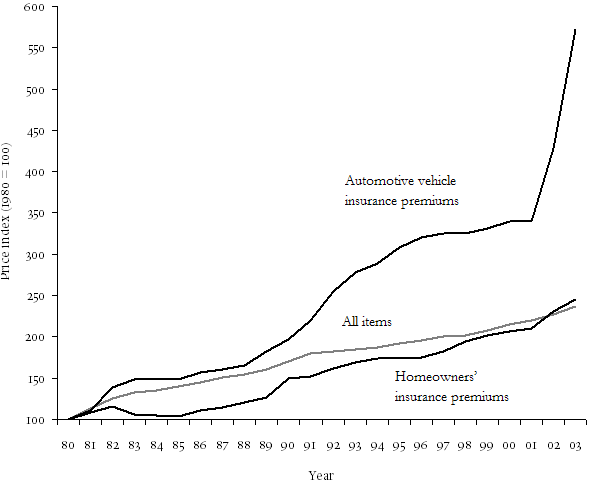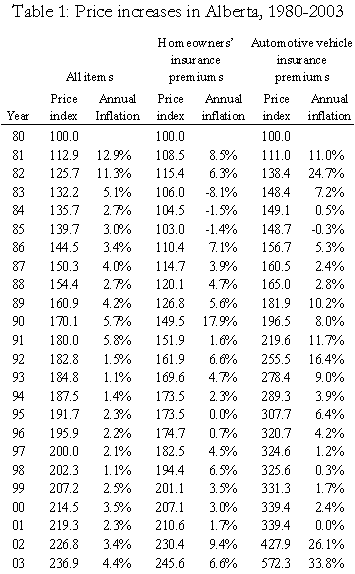by Christopher Bruce
Although automobile insurance rates seem to be in the news constantly, there is often confusion in the media about the process by which premiums are determined. The purpose of this article is to provide a brief introduction to that process. Three topics will be discussed: actuarial rating, rating classes, and experience rating.
1. Actuarial Rating
In Alberta – and all jurisdictions with private insurance – automobile insurance premiums are established through a technique that is generally referred to as “actuarial rating.” Fundamentally, under this system the premium the driver pays is equal to the cost that the insurance company expects the driver will impose upon it. If, on average, insuring a driver will cost the insurer $1,000 per year, the premium it will charge will equal $1,000 (plus an allowance for the company’s profit margin).
Assume, for example, that an insurance company has 10,000 customers; that there is a 10 percent chance that each driver will have an accident that results in an insurance claim each year; and that the average claim is $7,000. On average, therefore, 1,000 customers will make a claim each year, imposing a total cost of $7,000,000 on the insurer. Spread across the company’s 10,000 customers, therefore, the cost of claims, per customer, is $700.
In addition, the insurer will have to pay for its own costs of administration and will have to collect enough money to provide it with at least the minimum amount of profit to keep its shareholders satisfied. Assume that administrative costs amount to $250 per customer per year and that the minimum “acceptable” profit level can be represented as $50 per customer per year.
In this case, the insurer will have to collect at least $1,000 per year from each of its clients – $700 to cover the average cost of accident claims, $250 to cover administrative costs, and $50 for profit. The theory of actuarial rating predicts that this insurance company will set its premiums equal to that $1,000 figure. The “proof” of the theory’s prediction is as follows:
First, imagine that the company was to set a premium that was higher than $1,000, say, $1,050. Now, the company’s expected profit would be $100 per customer (= $1,050 – $700 – $250), twice the $50 figure that insurance companies require in order to remain in business. A second insurer would see the opportunity to make substantial profits by offering to insure the first company’s clients for less than $1,050, say $1,025. At this rate, its profits of $75 per customer would still be higher than the $50 that shareholders demand. But this would attract additional companies who would be willing to offer an even lower rate. As long as profit exceeds the minimum necessary to attract investors – that is, as long as the premiums charged exceeded $1,000, new firms would continue to enter the market, driving the premium down. In the long-run, the premium rate could not remain above the cost of insurance plus the minimum profit level.
Second, imagine that the insurer was to set its premium below $1,000, say at $900. It would soon discover that the costs of insurance exceeded the premiums that were being collected and it would be forced either to raise its premiums or to go out of business. In either event, premiums would rise until they at least equaled insurers’ costs (plus the minimum profit level).
In short, as long as there is competition in the insurance market – that is, as long as firms are able to compete for the business of their rivals; and firms do not collude to prevent such competition – the premium level will always tend towards the cost of insurance plus a minimal profit level. When premiums are set in this way, they are called “actuarially fair.”
2. Rating “Classes”
In the preceding discussion, I assumed that each client had the same probability of making a claim – 10 percent per year. In reality, of course, some customers have a higher claims probability than others. The theory of actuarial rating predicts that insurers will attempt to identify different “classes” of customers, according to those customers’ claims probabilities, and will charge a premium to each group that is a function of its accident risk.
Assume, for example, that the insurance company discussed above realizes that 2,000 of its 10,000 customers have a higher-than-average probability of making an insurance claim, say 20 percent per year. If it is still assumed that the average probability across all 10,000 customers is 10 percent, that implies that the probability that each of the company’s remaining 8,000 customers will make a claim is 7.5 percent. That is, when the 2,000 high-risk customers each have an accident probability of 20 percent and the 8,000 low-risk customers have an accident probability of 7.5 percent, the average probability of an accident across the two groups together is 10 percent. Thus, the expected number of claims is still 1,000 per year – 400 (= 0.20 × 2,000) by the high-risk group and 600 (= 0.075 × 8,000) by the low-risk group.
If the company continues to charge each of its customers $1,000 per year, it will still make an average profit of $50 per customer. (Because its customers have the same number of accidents and pay the same premiums, the same amount is left over for profit). However, if another company notices what is happening, it will realize that it could make a higher profit than average by attracting away some of the first company’s low-risk drivers.
For example, if the second insurer was able to attract 1,000 customers by charging $900 to the low-risk group, it would find that, on average, 75 of those customers (= 0.075 × 1,000) would have accidents. At an average cost of $7,000 per accident, total accident costs would be $525,000, or $525 per client. Assuming that administrative costs remained at $250, this company’s total costs per client would be $775, leaving a $125 profit from the $900 premium.
Soon, other insurance companies would recognize this profit-making opportunity and they would also offer reduced premiums to the low-risk group. By the theory of actuarial rating, the equilibrium premium for drivers in that group would eventually settle at $825 – the $775 cost per driver plus $50 for profit.
At the same time, as low-risk drivers were being attracted away from the first company, that company would find itself with a higher and higher percentage of drivers from the high-risk group. Assume that, ultimately, all of its clients came from that group. If each of those drivers had a 20 percent probability of making a claim and the average claim cost $7,000, then the average value of claims per driver would be $1,400. When $250 is added to this figure for administrative costs and $50 for profit, the firm would have to charge a premium of $1,700 to each of these drivers to remain in business.
But, high-risk drivers have no incentive to reveal to insurers that they have high probabilities of making claims; and low-risk drivers may find it difficult to signal credibly that they are members of the low probability group. (If insurance companies offer low premiums to those in the low-risk group, it will be in every driver’s interest to claim to belong to that group.)
Hence, insurance companies have looked for ways to construct “classes” of drivers based on characteristics that can be observed readily. There are two types of such characteristics – those over which drivers have little or no control, like age, sex, and (to a lesser extent) area of residence; and those over which they have a significant amount of control, like number of “fault” accidents and number of moving violations.
Age and Sex
It is well known that young males – and, to a lesser extent, young females – have a higher probability of making claims against their insurers than do older drivers. In this sense, young males are similar to the high-risk group discussed in the preceding section.
For this reason, in a competitive market, insurers will be forced to charge higher premiums to young males than to other groups. An insurance company that averaged all drivers together when setting its premiums (for example, setting a single premium of $1,000 in the example above) would soon lose all of its low-risk drivers to other firms that offered those drivers premiums that were related to their expected costs ($825 in the preceding example).
Furthermore, even though some young males are low-risk drivers, they will be charged the high premiums associated with their group. The reason is that, from the insurance company’s perspective, all young males look alike. As long as they drive the same kinds of cars, have the same driving records, etc, insurers will be unable to determine which young males are low risk and which are high.
In a competitive insurance market, there is no way around this issue. Any insurance company that offered premiums that were less than its expected costs of covering young males would find, first, that it would attract a very large percentage of young male drivers and, second, that it would, on average, lose money on those drivers. It would soon be forced to change its policy or be driven out of business.
Driving Experience
A second way of classifying drivers into low-risk and high-risk groups is to observe their driving behaviours. For statistical reasons, it is known that those who have had accidents in the current year have a higher than average probability of having accidents in the next year than do those who did not have accidents in the current year.
Assume again that there are two groups of drivers – 2,000 high-risk drivers, who have a 20 percent probability of making a claim in any given year, and 8,000 low-risk drivers, who have a 7.5 percent probability of making a claim. Assume also that the insurance company is unable to determine, on the basis of characteristics such as age and sex, which drivers belong in each category. In that case, the average probability of an accident across the two groups is 10 percent and, in the first year, the actuarial insurance premium will be $1,000.
During the first year, however, 400 of the high-risk drivers and 600 of the low-risk drivers will have accidents. This means that, among the group “drivers who had an accident in year 1,” 400, or 40 percent of the group, have a 20 percent chance of having an accident in year 2 and 600, (60 percent), have a 7.5 percent chance. On average, the drivers in this group have a 12.5 percent chance of having an accident in year 2. Their actuarial premium, (the premium that covers their expected costs plus profit margin), will be $1,175.
The remaining group, “drivers who did not have an accident in year 1,” will be composed of 1,600 drivers from the high-risk group and 7,400 from the low-risk group. Their average accident risk in year 2 will be approximately 9.72 percent and their actuarial premium will be approximately $980.
What is seen here is that the reason there is a premium differential between drivers who have had accidents and those who have not is not because insurers are trying to “recover the payments” they have had to make on behalf of clients who had accidents. Rather, because the group “those who have had accidents” has a disproportionate number of high-risk drivers (because they are the most likely to enter this group), its expected claims costs must be above average – meaning that its premiums will be proportionately higher also.
This means that the premium differential between those who have had accidents and those who have not will increase as the size of the high-risk group increases (thereby increasing their representation in the “have had an accident” group) and as the risk differential between low- and high-risk drivers increases.
3. Experience Rating
Automobile insurance is designed to protect the purchaser from catastrophic loss. The consumer pays an annual premium in return for a promise from the insurer that the latter will pay for any losses incurred by the former.
But insurance also has a second, unintended effect – it reduces the incentive for drivers to avoid accidents. In the absence of automobile insurance, drivers would have to bear the full financial impact of any negligent behaviour – under the assumptions used in the preceding section that would be $7,000 for each accident. This threat could be expected to induce them to take precautions against such behaviour.
In the presence of automobile insurance, however, the financial impact of negligent behaviour is the difference between the premium charged to drivers who have had accidents and those who have not. In the preceding section, it was shown that this amount could be quite small – less than $200 under the plausible assumptions employed there. This significant reduction in financial risk (relative to the no-insurance situation) can be expected to reduce substantially the incentive to avoid negligent behaviour.
In response, many commentators have suggested that the current actuarial rating system should be replaced by one based on experience rating – that is, a system in which premiums are tied closely to occurrences of driver negligence. For example, insurance companies might be required to ensure that the premiums charged to drivers who had had accidents or serious moving violations were at least double those charged to drivers who had “clean” driving records.
Note that experience rating cannot arise independently in a market in which a large number of firms compete for customers. As was shown in Section 1, above, competition forces firms to charge premiums that are based on actuarial rating. Experience rating can only arise in markets in which there is no competition – such as in provinces like British Columbia and Saskatchewan in which the government has a monopoly – or in jurisdictions in which the government establishes legislation to force private insurers to use that rating system.
Among the legislative changes that were contained in Alberta’s recent Bill 53, (see www.autoinsurance.gov.ab.ca/calculate.html), is a proposal to impose a version of experience rating. Although binding regulations have not been announced yet, the current proposal would require that insurers increase premiums by as much as 50 percent in the year following a single “at fault” claim and by an additional 30 to 40 percent in each subsequent year for six years or more; (that is, by as much as 250 percent when added across the six years following a single claim). The proposed system would also require that insurers increase premiums by 200 percent in each of the two years following a criminal code violation – such as impaired driving or criminal negligence causing death.
Economic theory predicts that experience rating systems – such as the one proposed by the Alberta government – will produce substantial increases in the levels of precautions taken by drivers – and corresponding substantial decreases in the number of accidents. It will be interesting to observe (i) whether the Alberta government will have the political willpower to force such a restrictive rating system on an unwilling and politically powerful insurance industry; and (ii) if it does so, whether such a system will yield the anticipated benefits.

Christopher Bruce is the President of Economica and a Professor of Economics at the University of Calgary. He is also the author of Assessment of Personal Injury Damages (Butterworths, 2004).







